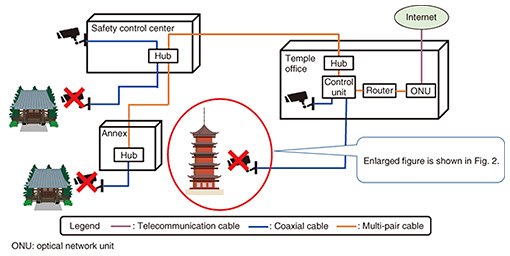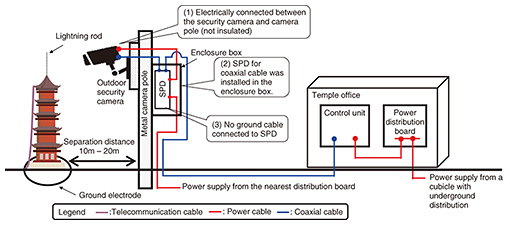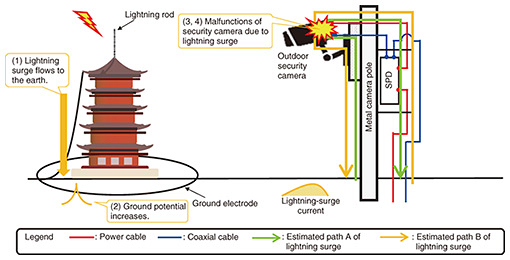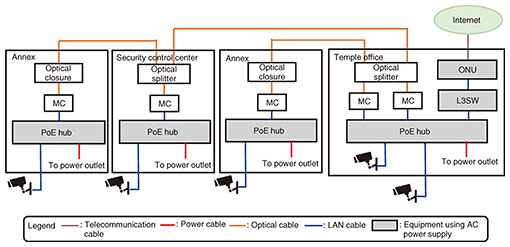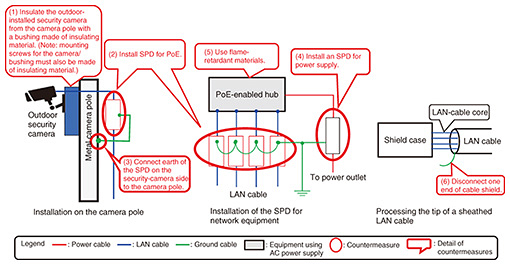 |
|
|
|
|
|
Practical Field Information about Telecommunication Technologies Vol. 21, No. 4, pp. 87–91, Apr. 2023. https://doi.org/10.53829/ntr202304pf1 Case Study of Malfunctions of Outdoor Security Cameras Caused by Lightning SurgeAbstractThis article introduces the malfunctions of outdoor security cameras caused by lightning strikes. The path of the lightning-surge current and countermeasures against the malfunctions are also explained. This is the seventy-fifth article in a series on telecommunication technologies. Keywords: lightning strike, outdoor security camera, surge protective device 1. IntroductionSecurity cameras have become widely used for crime prevention and safety management. The network configuration, the management function of which is centralized in one location, is suitable for monitoring a wide area with multiple cameras. To monitor a wide area, security cameras are often installed in places offering good visibility; however, such places are likely to be damaged by lightning strikes, which can cause problems such as equipment malfunction. To prevent such problems, it is necessary to configure equipment by taking countermeasures against lightning damage. An example of malfunctions of outdoor security cameras caused by lightning strikes is introduced in this article. 2. Malfunctions of outdoor security camerasA customer who used multiple outdoor security cameras on the premises of a temple reported that after a thunderstorm, the video images from three out of five security cameras were interrupted, and the images could not be displayed. We investigated the cause of the malfunctions and provided technical support concerning lightning-damage countermeasures for the customer’s planned upgrading of the security equipment. 2.1 Network and equipment configurationThe configuration of the security network when the malfunctions occurred is shown in Fig. 1.
The five security cameras (four outdoor and one indoor) are controlled and managed by a control unit located in the temple office, and the cameras and control unit are connected using coaxial cables. The three cameras that malfunctioned were all outdoor types, and other equipment did not malfunction. 2.2 Equipment conditions and results of on-site investigationsThe equipment conditions at a malfunction location and results of the on-site investigations are shown in Fig. 2.
A lightning rod is installed on the temple building and connected to a ground electrode buried around the building. The outdoor security cameras are installed on metal camera poles, and the distance between the building and security cameras is 10 to 20 meters. The power supply for the outdoor security cameras is fed from a power cable wired underground. We conducted an on-site investigation to check the installation conditions of the outdoor security cameras at the three locations where the malfunctions occurred and the equipment conditions connected to the cameras. The results of the on-site investigation were (1) the outdoor security cameras and camera pole were not insulated; (2) a surge protective device (SPD) for a coaxial cable was installed in an enclosure box near the camera, and the coaxial cable and power cable went through the SPD; and (3) the ground cable was not connected to this SPD. 2.3 Estimation of cause of malfunctions and lightning-surge pathConsidering the equipment conditions at the locations of the malfunctions and the results of the on-site investigation, we estimated the path of the lightning surge that caused the malfunctions (Fig. 3). (1) Due to a lightning strike to the lightning rod, the lightning surge flowed to the earth from the ground electrode. (2) Flow of the lightning surge into the earth caused an increase in the ground potential. (3) The increase in the ground potential caused the lightning surge to flow into the nearby camera pole (estimated path A) or into the coaxial-cable shield and power cable laid underground (estimated path B). (4) The lightning surges flowed through the camera pole and into the security camera (estimated path A) or flowed into the camera from the shield of the coaxial cable or power cable (estimated path B).
2.4 Countermeasures against malfunctions caused by lightning strikesThe basic countermeasures against malfunctions caused by lightning strikes are based on (i) preventing the lightning-surge current from flowing to the equipment, (ii) bypassing the lightning-surge current, and (iii) suppressing the potential difference between the equipment and installation site. Considering the equipment conditions and on-site investigation results discussed in Section 2.2 and the estimated causes of the malfunctions described in Section 2.3, we proposed the following basic countermeasures against lightning surge:
This temple is scheduled for equipment renewal, and the configuration of the new equipment is shown in Fig. 4 and summarized as follows:
Considering these modifications, we proposed the following lightning-damage countermeasures, which are also illustrated in Fig. 5. (1) To prevent lightning surges flowing into security cameras, insulate the security cameras from the camera poles with bushing made of insulating material. (2) To prevent the inflow of lightning surges from the LAN cables, fit PoE-compatible SPDs to the security cameras and hubs. (3) Connect SPD’s earth on the security-camera side to the camera pole. (4) To prevent the inflow of lightning surges from the power-supply system, insert an SPD into the power cable for equipment that uses AC power supply. (5) Select the equipment that uses flame-retardant materials. (6) When a LAN cable with a Cat6 or other PoE-compatible sheath is used, cut off one end of the cable shield (so that end is left open) to prevent breakdown of the insulation of the cable cores if a lightning surge enters the sheath.
From the viewpoint of fire prevention, taking countermeasures against tracking for the power outlet is also recommended. 3. ConclusionThis article introduced the malfunctions of outdoor security cameras caused by lightning strikes and countermeasures against those malfunctions. Equipment installed outdoors is at a higher risk of malfunction due to lightning, so it is necessary to configure equipment more reliably. At the Technical Assistance and Support Center (TASC), we will continue to play a role in reducing the operational load of maintenance by providing the knowledge we have accumulated. To reduce malfunctions caused by electromagnetic noise, radio, induction, lightning and improve the reliability of telecommunication services, the EMC Engineering Group of TASC will continue to engage in technical cooperation, development, and dissemination of technology through technical seminars and other activities. |
|









